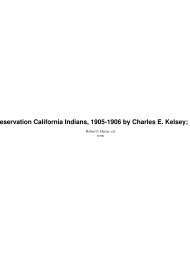The Geography and Dialects of the Miwok Indians - Yosemite Online
The Geography and Dialects of the Miwok Indians - Yosemite Online
The Geography and Dialects of the Miwok Indians - Yosemite Online
You also want an ePaper? Increase the reach of your titles
YUMPU automatically turns print PDFs into web optimized ePapers that Google loves.
1908] Barrett .—<strong>The</strong> <strong>Geography</strong> <strong>and</strong> <strong>Dialects</strong> <strong>of</strong> <strong>the</strong> <strong>Miwok</strong> <strong>Indians</strong> . 339<br />
three rods <strong>of</strong> willow, hazel, or o<strong>the</strong>r slender wood . In <strong>the</strong> extreme<br />
south, <strong>the</strong>se wooden rods are almost entirely supplanted by a<br />
multiple grass foundation.<br />
<strong>The</strong> woven hooded cradle, <strong>the</strong> looped stick mush-stirrer, <strong>and</strong><br />
<strong>the</strong> grass-foundation coiled basketry <strong>of</strong> <strong>the</strong> sou<strong>the</strong>rn <strong>Miwok</strong>, <strong>the</strong>y<br />
share with <strong>the</strong>ir neighbors <strong>of</strong> different family, <strong>the</strong> Yokuts <strong>and</strong><br />
Shoshonean Mono. <strong>The</strong> peculiar cradle, wooden mush-paddle,<br />
<strong>and</strong> rod-foundation basketry <strong>of</strong> <strong>the</strong> nor<strong>the</strong>rn <strong>Miwok</strong>, are found<br />
among <strong>the</strong> Maidu adjacent to <strong>the</strong>m . It is <strong>the</strong>refore evident that<br />
<strong>the</strong> difference in regard to <strong>the</strong>se implements can not be ascribed<br />
to independent cultural differentiations among <strong>the</strong> <strong>Miwok</strong>, but<br />
must be regarded as part <strong>of</strong> larger developments <strong>of</strong> culture affecting<br />
a region <strong>of</strong> which <strong>the</strong> <strong>Miwok</strong> held only part.<br />
<strong>The</strong>se three examples are among <strong>the</strong> most striking differences<br />
between <strong>the</strong> two divisions <strong>of</strong> <strong>the</strong> <strong>Miwok</strong>, <strong>and</strong> grow to be particularly<br />
noticeable in traveling through this region . A fuller<br />
investigation <strong>of</strong> <strong>Miwok</strong> implements, customs, <strong>and</strong> beliefs would<br />
very probably show o<strong>the</strong>r differences between <strong>the</strong>se nor<strong>the</strong>rn <strong>and</strong><br />
sou<strong>the</strong>rn regions . In <strong>the</strong> neutral region between Stanislaus <strong>and</strong><br />
Tuolumne rivers both types <strong>of</strong> each <strong>of</strong> <strong>the</strong> above-mentioned utensils<br />
are found. While <strong>the</strong> grass-foundation basket is typical <strong>of</strong><br />
<strong>the</strong> sou<strong>the</strong>rn area, it should not be understood that <strong>the</strong> willow or<br />
rod-foundation basket is not made . In fact it really predominates,<br />
<strong>the</strong> grass-foundation basket being <strong>the</strong> most common in<br />
point <strong>of</strong> numbers only in <strong>the</strong> extreme sou<strong>the</strong>rn part <strong>of</strong> <strong>the</strong> <strong>Miwok</strong><br />
area, in <strong>and</strong> about Mariposa. Likewise, <strong>the</strong> wooden cradle with<br />
cross rods is more particularly characteristic <strong>of</strong> <strong>the</strong> extreme<br />
nor<strong>the</strong>rn region.<br />
It has been impossible to investigate very fully such matters<br />
as ceremonial practices <strong>and</strong> mythology ; but from information<br />
obtained on <strong>the</strong>se points it seems probable that on fuller investigation<br />
along <strong>the</strong>se lines considerable differences will be found to<br />
exist between <strong>the</strong> nor<strong>the</strong>rn <strong>and</strong> sou<strong>the</strong>rn <strong>Miwok</strong> in <strong>the</strong>se respects<br />
also, no doubt with influence from <strong>the</strong> peoples to <strong>the</strong> north <strong>and</strong><br />
to <strong>the</strong> south. As to <strong>the</strong> influence <strong>of</strong> <strong>the</strong> stocks to <strong>the</strong> east, <strong>the</strong><br />
Washo <strong>and</strong> Shoshonean, <strong>and</strong> <strong>the</strong> nor<strong>the</strong>rn branch <strong>of</strong> <strong>the</strong> Yokuts<br />
to <strong>the</strong> west, too little information is now available to make comparisons<br />
possible ; in <strong>the</strong> case <strong>of</strong> <strong>the</strong> Washo <strong>and</strong> Shoshonean


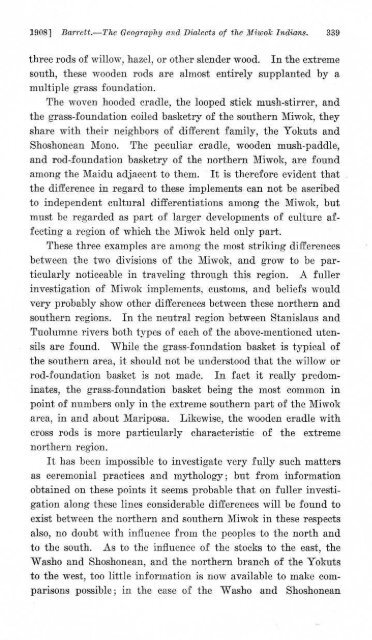

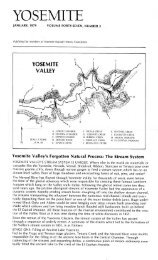
![(March 1982) [PDF] “We Are Pleased to Announce†- Yosemite Online](https://img.yumpu.com/51299748/1/190x242/march-1982-pdf-aeuroewe-are-pleased-to-announceaeur-yosemite-online.jpg?quality=85)
![[PDF] Old Horny, Yosemite's Unicorn Buck - Yosemite Online](https://img.yumpu.com/51269869/1/184x260/pdf-old-horny-yosemites-unicorn-buck-yosemite-online.jpg?quality=85)
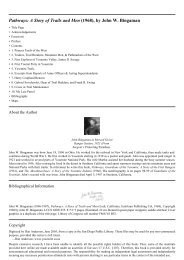
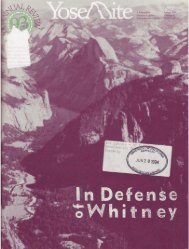
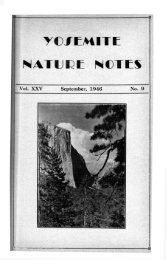
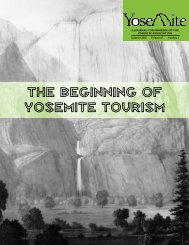
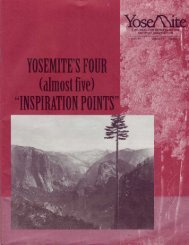
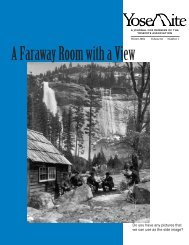
![1985 [PDF] - Yosemite](https://img.yumpu.com/48128837/1/184x260/1985-pdf-yosemite.jpg?quality=85)

